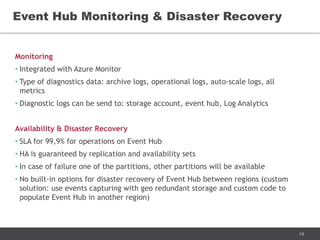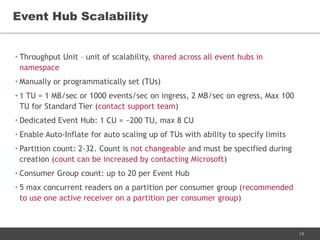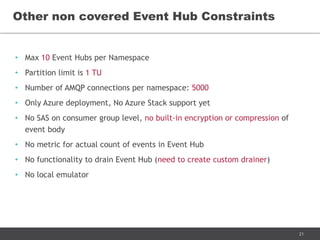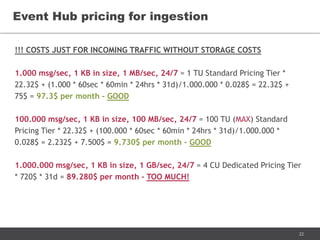High throughput data streaming in Azure
- 1. High-throughput data streaming in Azure Alexander Laysha Solution Architect at EPAM Systems & Microsoft Azure MVP
- 2. 2 Few words about myself… I’m Alexander Laysha • Solution Architect from EPAM Systems & Microsoft Azure MVP • Focused on backend, high-load and cloud solutions • Leader of Belarus Azure Community • Speaker at local and external meetups and conferences My contacts • Email: [email protected] • Twitter: @layshaalexander • Facebook: alexander.laysha
- 3. 3 • Business needs for real-time analytics • Use-cases & architecture approaches • Basics of real-time data streaming platforms • Azure Event Hub capabilities & constraints • Pricing calculations for multiple data ingestion scenarios based on Event Hub • Summary Which topics will we cover?
- 4. 4 Past world • Capture data for later analysis • Reports and analytics with X days latency Current days • Dealing with tons of data • Offline report and analysis in no longer enough (but still important) • Business want to get immediate insights from captured data with X seconds/minutes latency Business needs for data analytics
- 5. 5 IoT – device operational intelligence and pro-active alerts Gaming Industry – real-time board with game leaders and scores E-Commerce – online recommendation engines and proactive care Operations - analyze real-time data to respond to dynamic environments in order to take immediate action Financial - monitor financial transactions in real-time to detect fraudulent activity Just few use-cases…
- 6. 6 Collection – captured data from multiple sources Streaming - high-throughput data pipeline systems like Kafka, Kinesis, Event Hub Processing – stream processing platforms that performs a certain task to produce output Serving – app for stream processing output consumption – UI, posts, DB, report viewers, APIs High-level real-time streaming architecture OUR FOCUS
- 7. 7 Persistence and batch - data is stored in a persistence layer from which it is ingested and processed by the batch layer periodically (may includes stream processing for on-fly ETL) Speed layer - handles the portion of the data that has not-yet been processed by the batch layer (includes stream processing and storage) Serving layer - consolidates both by merging the output of the batch and the speed layer High-level view of Lambda Architecture
- 8. 8 High-level view of Kappa Architecture Persistence – stores initial raw data for historical purposes and can be used to replay computations from initial data stream Speed Layer - the basic idea is to not periodically recompute all data in the batch layer, but to do all computation on Speed Layer in the stream processing system alone and only perform recomputation when the business logic changes by replaying historical data
- 9. 9 Popular platforms for data streaming Kinesis Event Hub
- 11. 11 Common terminology Producer Producer Producer Publisher Consumer Consumer Kinesis Stream Applications Consumer Stream Topic Stream Event Hub Partition Partition Shard Partition Index Offset Sequence Number Offset Consumer Group Consumer Group Application Consumer Group
- 12. 12 • Designed to handle very large quantities of small messages • Horizontally scalable by using partitions and consumer groups • Reliable and fault-tolerant • Configurable data replication • Configurable message TTL (stream level) • Supports at-least-once delivery • Logical data organization using partitions • Separate date view for consumer by using consumer groups and indexes • Ability to replay messages • Messages with the same key are sent to the same partition • Guarantee of message order in scope of partition • Integrated with modern stream processing platforms (Stream Analytics, Storm, Spark, etc.) Common characteristics
- 13. 13 Let’s take a close look to Azure Event Hub Event Producers > 1M Producers > 1GB/sec Aggregate Throughput Direct PartitionKey Hash Throughput Units: • 1 ≤ TUs ≤ Partition Count • TU: 1 MB/s writes, 2 MB/s reads Namespace
- 14. 14 Ways to publish - individual event or batch: • Round Robin • Partition Id • Partition Key Supported Protocols: • HTTPS – short-lived (low throughput) • AMQP 1.0 – long-lived, (high throughput) Publisher Policy - run-time feature designed to facilitate large numbers of independent event publishers by using unique identifier and virtual endpoint: //[my namespace].servicebus.windows.net/[event hub name]/publishers/[my publisher name] Event Hub Publishers Event Producers
- 15. 15 Events listening - consumer connects to a partition using AMQP 1.0 protocol and listens for incoming events Consumer Groups - is a view (state, position, or offset) of an entire event hub. Consumer groups enable multiple consuming applications to each have a separate view of the event stream, and to read the stream independently at their own pace and with their own offsets Event Hub Consumers
- 16. 16 • Security model is based on Shared Access Signature (SAS) tokens • Shared access policy (key) supports following claims: Send, Listen, Manage • Shared access policy (key): • can be created on namespace or event hub level • includes Primary and Secondary keys • Primary and Secondary key can be revoked • SAS tokens can be created on namespace, event hub or publisher level • Granular control over event publishers through publisher policies (publisher name should be the same as partition name, SAS token should be for publisher endpoint) • Event publishers can be revoked in case of usage of publisher specific SAS token Event Hub Security
- 17. 17 • Automatic persistence of ingested events from Even Hub in Apach Avro format • Supported storages: • Azure Storage • Azure Data Lake • Configurable size & time windows per partition Event Hub Capturing
- 18. 18 Monitoring • Integrated with Azure Monitor • Type of diagnostics data: archive logs, operational logs, auto-scale logs, all metrics • Diagnostic logs can be send to: storage account, event hub, Log Analytics Availability & Disaster Recovery • SLA for 99,9% for operations on Event Hub • HA is guaranteed by replication and availability sets • In case of failure one of the partitions, other partitions will be available • No built-in options for disaster recovery of Event Hub between regions (custom solution: use events capturing with geo redundant storage and custom code to populate Event Hub in another region) Event Hub Monitoring & Disaster Recovery
- 19. 19 • Throughput Unit – unit of scalability, shared across all event hubs in namespace • Manually or programmatically set (TUs) • 1 TU = 1 MB/sec or 1000 events/sec on ingress, 2 MB/sec on egress, Max 100 TU for Standard Tier (contact support team) • Dedicated Event Hub: 1 CU = ~200 TU, max 8 CU • Enable Auto-Inflate for auto scaling up of TUs with ability to specify limits • Partition count: 2-32. Count is not changeable and must be specified during creation (count can be increased by contacting Microsoft) • Consumer Group count: up to 20 per Event Hub • 5 max concurrent readers on a partition per consumer group (recommended to use one active receiver on a partition per consumer group) Event Hub Scalability
- 20. 20 • Single tenant hosting with no noise from other tenants, available to customers with an enterprise agreement • Repeatable performance every time • No additional charge for incoming messages • Message size increases to 1 MB as compared to 256 KB for Standard and Basic • Scalable between 1 and 8 capacity units (CU) – providing up to 2 million ingress events per second • CUs manage the scale for Event Hubs Dedicated, 1 CU = ~200 TU, max 8 CU • Zero maintenance: management of load balancing, OS updates, security patches, and partitioning • Fixed monthly pricing: ~720$ per day for 1 CU (pricing & CU size will change starting from October 2017: ¼ CU for 5000$ per month) Dedicated Event Hub
- 21. 21 • Max 10 Event Hubs per Namespace • Partition limit is 1 TU • Number of AMQP connections per namespace: 5000 • Only Azure deployment, No Azure Stack support yet • No SAS on consumer group level, no built-in encryption or compression of event body • No functionality to drain Event Hub (need to create custom drainer) • No local emulator Other non covered Event Hub Constraints
- 22. 22 !!! COSTS JUST FOR INCOMING TRAFFIC WITHOUT STORAGE COSTS 1.000 msg/sec, 1 KB in size, 1 MB/sec, 24/7 = 1 TU Standard Pricing Tier * 22.32$ + (1.000 * 60sec * 60min * 24hrs * 31d)/1.000.000 * 0.028$ = 22.32$ + 75$ = 97.3$ per month - GOOD 100.000 msg/sec, 1 KB in size, 100 MB/sec, 24/7 = 100 TU (MAX) Standard Pricing Tier * 22.32$ + (100.000 * 60sec * 60min * 24hrs * 31d)/1.000.000 * 0.028$ = 2.232$ + 7.500$ = 9.730$ per month - GOOD 1.000.000 msg/sec, 1 KB in size, 1 GB/sec, 24/7 = 4 CU Dedicated Pricing Tier * 720$ * 31d = 89.280$ per month - TOO MUCH! Event Hub pricing for ingestion
- 23. 23 • Azure Event Hub is capable to handle middle-loaded scenarios (100.000 msg/sec or 100 MB/sec) in cost affective manner and provides good feature parity • For high-loaded scenarios (1.000.000+ msg/sec or 1+ GB/sec) or big-data scenarios it seems too expensive (Apache Kafka cluster more cheaper but requires invest into tuning & maintenance costs) • Always consider quality attribute requirements for your system before moving forward with technology decisions. PaaS is not always right choice in case of high-loaded scenarios Summary
- 24. 24 Q & A THANK YOU!
Editor's Notes
- #5: https://www.slideshare.net/hadooparchbook/streaming-architecture-patterns
- #11: http://container-solutions.com/introduction-stream-processing-systems-kafka-aws-kinesis-azure-event-hubs/
- #13: https://blogs.msdn.microsoft.com/opensourcemsft/2015/08/08/choosing-between-azure-event-hub-and-kafka-what-you-need-to-know/ http://container-solutions.com/introduction-stream-processing-systems-kafka-aws-kinesis-azure-event-hubs/



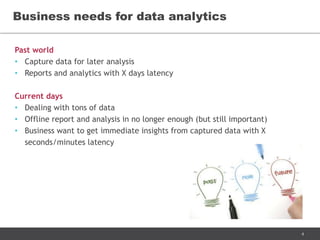
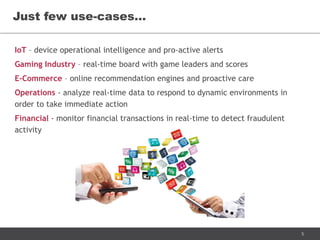
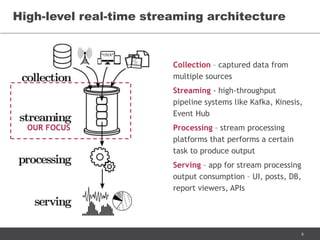

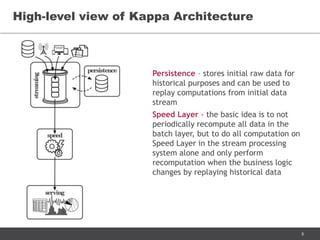

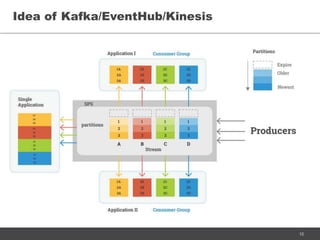


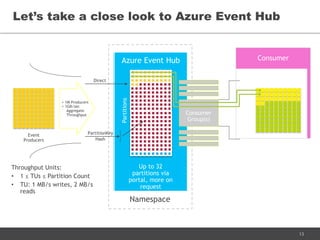
![14
Ways to publish - individual event or batch:
• Round Robin
• Partition Id
• Partition Key
Supported Protocols:
• HTTPS – short-lived (low throughput)
• AMQP 1.0 – long-lived, (high throughput)
Publisher Policy - run-time feature designed to facilitate large numbers of
independent event publishers by using unique identifier and virtual endpoint:
//[my namespace].servicebus.windows.net/[event hub
name]/publishers/[my publisher name]
Event Hub Publishers
Event
Producers](https://image.slidesharecdn.com/high-throughputdatastreaminginazure-170912201108/85/High-throughput-data-streaming-in-Azure-14-320.jpg)



